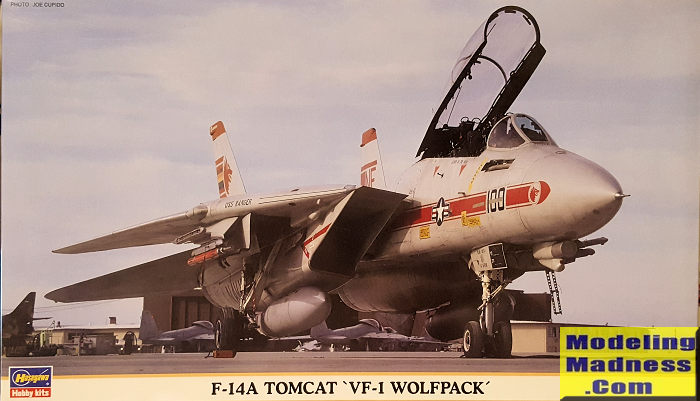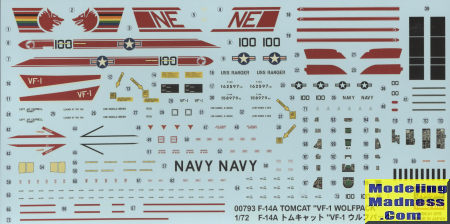
Hasegawa 1/72 F-14A "VF-1 Wolfpack"
| KIT #: | 00793 |
| PRICE: | 3000 yen SRP |
| DECALS: | Two options |
| REVIEWER: | Scott Van Aken |
| NOTES: | 2006 Limited reissue |

| HISTORY |
The Grumman F-14 Tomcat is a supersonic, twin-engine, two-seat, variable-sweep wing fighter aircraft. The Tomcat was developed for the United States Navy's Naval Fighter Experimental (VFX) program following the collapse of the F-111B project. The F-14 was the first of the American teen-series fighters, which were designed incorporating the experience of air combat against MiG fighters during the Vietnam War.
The F-14 first flew in December 1970 and made its first deployment in 1974 with the U.S. Navy aboard USS Enterprise (CVN-65), replacing the McDonnell Douglas F-4 Phantom II. The F-14 served as the U.S. Navy's primary maritime air superiority fighter, fleet defense interceptor and tactical aerial reconnaissance platform. In the 1990s, it added the Low Altitude Navigation and Targeting Infrared for Night (LANTIRN) pod system and began performing precision ground-attack missions.
Throughout most of its life, the F-14 was hampered by the TF-30 engines originally designed for the F-111B. These caused some issues and did not allow the full utilization of the Tomcat's design capabilities. It was planned on using F-401 engines but issues with the engines and budget concerns shelved that. It wasn't until many years later that the F-110 engine was installed in some F-14A airframes making those F-14A+ and later F-14B aircraft. The upgraded F-14D had these same engines and upgraded digital avionics with about half of the F-14D production being reworked F-14As.
In the 1980s F-14s were used as land-based interceptors by the Islamic Republic of Iran Air Force during the Iran–Iraq War, where they saw combat against Iraqi warplanes. Iranian F-14s reportedly shot down at least 160 Iraqi aircraft during the war, while only 12 to 16 Tomcats were lost; at least half of these losses were due to accidents.
The Tomcat was retired from the U.S. Navy's active fleet on 22 September 2006, having been supplanted by the Boeing F/A-18E/F Super Hornet. The F-14 remains in service with the Islamic Republic of Iran Air Force, having been exported to Iran in 1976, when the U.S. had amicable diplomatic relations with Iran.
| THE KIT |
As demanded, the panel lines are engraved and the kit offers the ability to have the flaps and slats deployed. In fact, to do it otherwise will require a bit of surgery to be done on the slat tracks. You can also position the glove vanes open or closed. Again, some surgery is needed for the closed position. All F-14s had them wired in the closed position after it was realized that they didn't really do anything and were an additional maintenance hassle. You also have the ability to have the speed brakes and entrance steps/ladder open or closed, and two different tails, though one set is not for this particular boxing. So much has the F-14 been modified and updated over the years that you really need to have photographs of the aircraft that you are modeling to get everything right.
As required by its price, this kit comes with a small fret of etched metal. These bits are for the interior, canopy and exhaust. The metalwork is very well done and should really enhance your Tomcat.
 For markings, we have
two aircraft, both from VF-1. One is the box art plane in overall gloss gull
grey with the color that is supposed to be in a CAG bird. Photo below. The other
is one of the Ferris schemes with minimal markings and no unit identifier or
codes. The kit provides a set of earlier instructions along with an addendum
sheet that not only provides painting and markings info, but also changes to
several of the construction steps. Decals are very nicely done and should work
just fine. As a note, VF-1 was one of the first operational Tomcat squadrons to
be disestablished (VF-191 and VF-194 were never fully operational) and has faded
into history, though not from the minds of modelers as it is quite popular with
F-14 modelers.
For markings, we have
two aircraft, both from VF-1. One is the box art plane in overall gloss gull
grey with the color that is supposed to be in a CAG bird. Photo below. The other
is one of the Ferris schemes with minimal markings and no unit identifier or
codes. The kit provides a set of earlier instructions along with an addendum
sheet that not only provides painting and markings info, but also changes to
several of the construction steps. Decals are very nicely done and should work
just fine. As a note, VF-1 was one of the first operational Tomcat squadrons to
be disestablished (VF-191 and VF-194 were never fully operational) and has faded
into history, though not from the minds of modelers as it is quite popular with
F-14 modelers.

| CONCLUSIONS |
Hasegawa has made the most out of its tooling of this kit and it does provide a goodly amount of detail for the price. Despite newer kits out there, this is still a very nice kit and well worth building.
| REFERENCES |
http://en.wikipedia.org/wiki/F-14_Tomcat
March 2022
Copyright ModelingMadness.com. All rights reserved. No reproduction in part or in whole without express permission from the editor.
If you would like your product reviewed fairly and quickly, please contact me or see other details in the Note to Contributors.